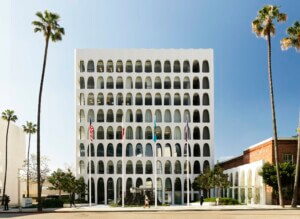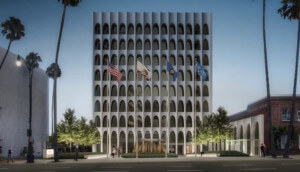| Brought to you by: |
New learning center gives an in-progress look at lightweight structural design
Construction is underway on the first academic facility in almost two decades to be built on the Claremont, California, campus of Harvey Mudd College. Designed in 1956 by Edward Durrell Stone, the 39-acre school is a private engineering, science, and math institution, which is planning for growth in the coming decade.
“A lot of their current classrooms are underground so they were literally wanting to bring these into the light,” said Amy Donohue, a principal at Boora Architects. The Portland-based firm has designed a new 70,000-square-foot Teaching and Learning Center to create a bridge between academic facilities located to the west and dorms to the east. Though the design emphasizes transparency, energy efficiency, and a range of academic and social functions, a unique bi-axial hollow slab structural system concealed in the building’s concrete will have one of the greatest impacts on reducing material use as it targets LEED Platinum certification.
- Fabricator BubbleDeck
- Architect Boora Architects
- Location Claremont, California
- Status In progress
- Materials Recycled plastic balls, mesh reinforcement, precast and poured concrete
- Process Lightweight slab design and engineering
The system, created by Denmark-based BubbleDeck, has long been used in Europe and Canada, but the Learning Center is poised to be the first U.S. academic building to use the product. By replacing non-functional concrete with recycled plastic balls suspended between reinforcing mesh, the system is about 35 percent lighter than a traditional concrete slab.
Boora began to consider the BubbleDeck system because of the amount of weight it could eliminate from the building’s structure. The system allowed designers to keep the layout as open as possible, with high ceilings and clear spans of 35 feet between columns. “If you were doing that with a typical slab and beam or with steel, you would end up with deep beams that cut into the overall height of the classrooms,” said Donohue. The Learning Center’s slim 13-inch floor slab leaves almost 14 feet of the 15-foot floor-to-floor height clear, even with ductwork and electrical elements installed. Shear walls are also thinner than they would have been with a traditional concrete slab because of the BubbleDeck’s decreased weight.
Though the system proved to be comparable in price to a traditional slab, its implementation in such a high-profile building came with a learning curve for all. Boora worked with the company to feed cost information to construction manager Matt Construction. The team in turn worked with structural engineer KPFF to design each floor slab, modifying some slab embed details and engineering the building’s green roofs for the added load of soil. Where there is occupied space over open courtyard areas, the plastic balls are filled with insulation with an R-value of 3.7 per inch. “We also had to work closely with the city’s structural code review department,” said Donohue. “The calculations that KPFF had to take into account are traditional, but we definitely had to talk it through with the code reviewer.”
BubbleDeck also consulted with the precast concrete manufacturer and installer, both of whom were working with the system for the first time. Installers recently finished placing the building’s floor panels, containing more than 90,000 plastic balls, in only two days. Overall approximately 80 percent of the school’s first through fourth floors will use BubbleDeck. “It provides the finish quality of concrete with the erection time of steel,” said Donohue of the system. “You have beautiful ceilings that are basically precast concrete, but they take no time to assemble.”
In the long term, the system will also allow the college to renovate more easily—outlets or new openings can be made by core-drilling into the slab rather than breaking through 13 inches of concrete. “You’re basically popping a bubble,” said Donohue. “It’s a very smart system.” In that way, the design also has something in common with the school’s innovation-minded students, who expect to move into the new building in 2013.










